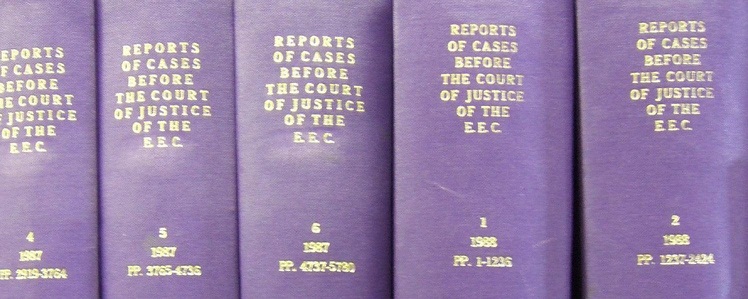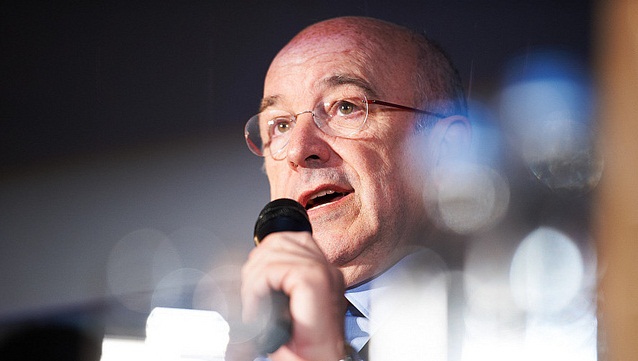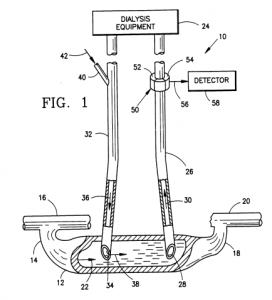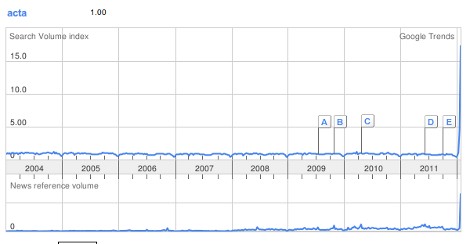This is a follow-up to Volker ‘Falk’ Metzler’s previous posting titled In Defense of Articles 6 to 9 of the Unitary Patent Regulation and, in particular, to the discussion induced by it.
As can be learnt from the public discussion of the role of the Court of Justice of the European Union (CJEU) and of the European Court of Justice (ECJ) in the context of the planned Proposal for a Regulation of the Council and the European Parliament implementing enhanced cooperation in the area of the creation of unitary patent protection as well as with regard to the still unfinished Draft agreement on a Unified Patent Court there appears to exist – at least in some quarters – a sort of general discontent with the work of those judges presiding in Luxembourg over the entire body of EU law.
For example, our reader Derek Clapton (maybe a pseudonymous author identification?) puts his view on the CJEU in this brief summarising sentence:
To say that the ECJ “is the best functioning institution of the Union” is like saying that Amsterdam is the highest place in the Netherlands – possibly true, but an unimpressive boast nonetheless.
Well, I think it might be interesting to have some deeper insight into the factual basis of this damnation. Mr Clapton gives us a clue when he writes:
If, in answering questions such as how to determine the scope of protection of a patent claim, the ECJ introduces the same degree of uncertainty in patent law as it has in the case of trade mark law, the EU patent system will fail its users, which may lead to manufacturers deciding to locate new factories outside of the court’s jurisdiction. In such case, Spain may be well advised to remain outside of the proposed EU patent arrangements.
And another commenter Peter Lustig (maybe another pseudonymous identification?) argues:
Usually, one would expect renowned senior practitioners of his kind to join him and support his argumentation – there appear to be none so far. Also, the Article 6 to 9-issue is only one in a row of objections, some going to the very core of the project (e. g. the compatibility with the AETR case law of the CJEU) and still remaining unaddressed. With all due respect, but Professor Tilmann’s outstanding reputation should not be allowed to replace founded answers to legitimate questions.
And, even Dr. Jochen Pagenberg himself joins the line of comments by arguing, inter alia, as follows:
If one wants a really unattractive, inefficient, unpredictable and probably extremely expensive patent court system, then we will get it; one must only give the ECJ a chance to receive as many referrals in patent law as possible.
If one wants to see substantive patent law in Europe to be decided by judges without any solid knowledge and experience in this field, then one must involve the ECJ whenever possible.
Well, is this real? It is fair to say that as a humble patent and trade mark attorney I never shall deal with those EU judges in Luxembourg myself. But I have to carefully read important decisions, in particular in the field of trade mark law. And, yes, there are decisions of the Court which I find questionable but that also holds for me when studying decisions from German Courts. A well-known and a bit semi-ironic German proverb says that in court and on the high seas we all are in the hands of the Lord, indicating that awaiting a decision of a Court always bears a momentum of unpredictability. Are the high seas of the CJEU / ECJ excessive in this respect?
Continue reading »
Articles 6 to 9 of the Unitary Patent Regulation relate to substantive patent law. They regulate the right to prevent direct and indirect use of the invention (Art. 6 and 7, respectively), the limitation of the effects of the ‘Unitary Patent‘ (Art. 8) and exhaustion of the rights conferred by the ‘Unitary Patent‘ (Art. 9).
As the question of which EU member state will receive the Central Division of the EU Unified Patent Court (see here, here, and here) is officially seen as the only remaining obstacle to the Unified Patent Court Agreement, the Unitary Patent Regulation already received green light from the EU Parliament’s legal committee (JURI) in late December (see press release) so that the EU Council already began to linguistically finalise the Regulation text in early January.
THE DISPUTE ON ARTICLES 6 TO 9
Even so, a strong and illustrious ‘opposition movement’ of legal professionals and their associations (e.g. EPLAW and Jochen Pagenberg, European Patent Judges and Sir Robin Jacob, Professor Krasser, CIPA), industry representatives (e.g. ICC, IP Federation), and a few politicians (e.g. JURI member Cecilia Wikström (SE, ALDE) [1, 2, 3] and UK IP Minister Baroness Wilcox) demanded Articles 6 to 8/9 to be removed from the Regulation to prevent substantive patent law from becoming subject to review by the European Court of Justice via referral questions according to Article 267 TFEU.
In one of our latest postings on the legal and political shadows of the Unified Patent Court Agreement we concluded that the stuck ‘seat issue’ will now have to be decided on the top executive level, i.e. in personal talks between Federal Chancellor Angela Merkel, Prime Minister David Cameron, and - should he survive the French presidential election in April/May 2012 - Nicolas Sarkozy as the only serious and realistic bits were Berlin, London, and Paris, respectively.
While the German government always claimed the seat of a European Patent Court, should such court ever exist, London became a candidate rather late and only after intervention of the UK legal profession and Paris was considered a compromise location to prevent a deadlock between Munich and London. None of these bits is ideal for everyone as each has considerable drawbacks, as has been recently summarised on FT.com “few other EU countries are happy with a Munich seat because the city is already the home to EPO“, “Britain lacks goodwill or allies“, and “French inflexibility has been damaging“.
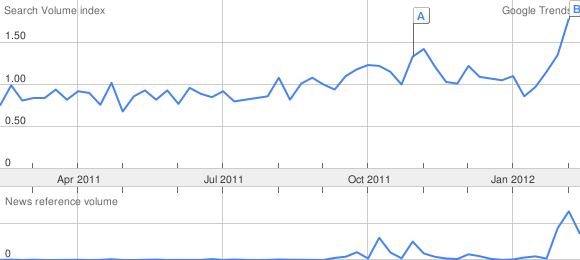
- Occurrence of the term “FRAND” in Google searches during the previous 12 months. In November 2011 (A) the EU Commission started investigations against Samsung due to possible infringement of FRAND conditions. In February 2012 (B) Google announced that the acquired Mororola patents will remain to be licensable under FRAND conditions.
In Part 1 of our series of two postings on political and business issues in the discussion on FRAND licensing in Europe, we sketched the EU Commission’s political approach towards maintaining free markets in times of standard-essential patents.
Now, in Part 2, we will have a closed look at what the various industry players in the ‘smartphone war’ say and do.
The ‘Smartphone War’: The significance of Mr Almunia’s agenda can be easily derived for the global patent conflict that initially started between Apple and Samsung and meanwhile, after months of infringement suits and injunctions, involves also essentially all other important Internet and mobile telco players such as Google, Motorola, Microsoft, Nokia and HTC. In an earlier posting we considered this to be a sort of stress test for the patent system as it currently is.
This is the first in a series of two postings – the second part will be published later today -, that relate to both the political and business attitude towards FRAND licensing in Europe. As there are two main players in that game, namely the EU Commission as the political market watch-dog and the Smartphone industry as patent holders and actors on these markets, we will first have a look at the political agenda of the EU Commission towards ensuring free market access in a world of standard-essential patents, as articulated in clear words only recently. In the light of the Commissions approach, the hint at the “Commission’s position as regulator-in-chief of the global technology industry”, as seen by the Financial Times back in 2007 , might never have been more true than today.
After months of intense debate in the EU Council and the EU Parliament’s Legal Affair’s Committee (JURI), the European Parliament was scheduled to have its fist plenary session on the EU Patent Package (Unitary Patent Regulation, Language Regime Regulation, Unified Patent Court Agreement) on coming Wednesday, 14 February 2012.
While Google Search still delivers an entry “Plenary sitting – European Parliament Tuesday, 14 February 2012 Draft agenda. 09:00 – 10:20 Debates. European patent. Creation of unitary patent protection.“, the final draft agenda now announces a Fisheries debate instead.
Recently the European Patent Office (EPO) has published Decision T 1695/07 – 3.3.07 of one of the Boards of Appeal dealing with the exception from patentability under Article 53(c) EPC. The catchword reads as follows:
I. A blood manipulation process involving the continuous removal of blood from a patient, its subsequent flowing through a circulating line of an extracorporeal circuit and its re-delivery to the patient is a method of treatment of the human body by surgery excepted from patentability under Article 53(c) EPC. It does not belong to the kind of methods which should not be covered by the exception clause according to the “narrower understanding” suggested by the Enlarged Board of Appeal in decision G 1/07, because the process is not performed in a “non-medical, commercial environment” and cannot be considered as a “minor intervention” being performed on “uncritical parts of the body” (Reasons, 8 to 10).
II. Such an in vivo process requires “professional medical expertise” and belongs to the kind of interventions representing the “core of the medical profession’s activities”, even when performed by paramedical support staff (Reasons, 11).
III. Even when the process is carried out with the required medical professional care and expertise, it involves ”substantial health risks” for the patient. A health risk is considered to qualify as “substantial” whenever it goes beyond the side effects associated with treatments such as tattooing, piercing, hair removal by optical radiation, micro abrasion of the skin as mentioned in G 1/07. A factual analysis of absolute or relative risks and their likelihood of occurrence based on objective evidence is hardly feasible and should therefore not be required.
In the Decision the Board argues the claimed process does not fall under the “narrower understanding”, i.e. does not belong to the kind of methods which should not be covered by the exception clause according to the criteria developed in G 1/07 because of it comprises the steps of
- “continuously removing blood from a downstream location in the shunt (12) …” and
- “delivering the removed blood flowing in said circulating line by way of an outlet connected to an outlet side of said circulating line to an upstream location of said shunt, …”.
Furthermore and again according to the Board, It has been established that these steps are invasive and represent a substantial physical intervention on the body which requires professional medical expertise to be carried out and which entails a substantial health risk even when carried out with the required professional care and expertise. ccording to the established jurisprudence of the Boards of Appeal, a multi-step method falls under the exception clause of Article 53(c) EPC, if it includes at least one feature that constitutes a method step for the treatment of the human body by surgery. The possible technical contribution of the invention as mentioned by the proprietor appellants is not a criterion to be taken into consideration in this context.
As reported earlier, the public debate on the Anti-Counterfeiting Trade Agreement between the European Union and its Member States, Australia, Canada, Japan, the Republic of Korea, the United Mexican States, the Kingdom of Morocco, New Zealand, the Republic of Singapore, the Swiss Confederation and the United States of America (ACTA) is currently gaining momentum. One of the many problems with ACTA is that it appears not to be clear as to whether or not the Treaty will actually change the law of at least some of its Member states.
In this context it appears to be worthwhile to bring back into memory that – unlike the SOPA and PIPA Bills recently stalled in the U.S. – ACTA is a Treaty of public international law, not civil law or public national law. The Articles thereof clearly address not individuals or corporations but its Member States (‘Parties’) and imposes on them an obligation to uphold certain minimum standards with regard to enforcement of intellectual property law. Article 2 Para. 1 of ACTA reads [emphasis added]:
Each Party shall give effect to the provisions of this Agreement. A Party may implement in its law more extensive enforcement of intellectual property rights than is required by this Agreement, provided that such enforcement does not contravene the provisions of this Agreement. Each Party shall be free to determine the appropriate method of implementing the provisions of this Agreement within its own legal system and practice.
In this context it does not come as a surprise that in some of the ACTA signatory states some (if not many) of the provisions provided by ACTA are already in force. For example, in Germany the first Act on Product Piracy (“Produktpirateriegesetz”) dates back to March 07, 1990. It introduced, inter alia, a right to information addressing the infringer to disclose otherwise confidential information concerning the act of infringement as well as provisions to seize and destroy counterfeit goods. Today, in the EU the laws governing the enforcement of intellectual property right in general and especially the fight against piracy are widely harmonised by secondary EU law.
Continue reading »
As should be well known to everyone working on patents, copyright, trade marks and the like, the Anti-Counterfeiting Trade Agreement (ACTA) is a plurilateral agreement for the purpose of establishing international standards for intellectual property rights enforcement. In an earlier post on this blog I had reported in October last year on preparations for signing and ratification of ACTA in the EU, predicting that an epic battle on the ratification of ACTA is looming. Meanwhile, the Agreement has been signed on behalf of 31 Member States and on behalf of the EU as well.
It is absolutely safe to state that the public debate on ACTA has not calmed down. To the contrary, tensions are soaring as demonstrated by the Google Trends graph shown above: Just in these weeks and days the public interest in ACTA related matters as perceived by Google search engine has increased dramatically; look at the leading slope near the right-hand border of the plot. Fueled by real or imaginative parallels to the SOPA and PIPA Bills recently stalled in the U.S., broader circles of those parts of the general public engaged in Internet politics had a closer look into the ACTA matter, and many were not amused. Twitter timelines are buzzing with statements of discontent concerning ACTA; in Germany, protest demonstrations are scheduled to happen on February 11, 2012. In Poland, protest demonstrations with tens of thousands of participants have already been reported during past days (see also another video here).On January 26, Mr Kader Arif, the rapporteu for ACTA in the respective Committee of the European Parliament, stepped down, dismissing the entire political process of the creation of ACTA as follows:
“I condemn the whole process which led to the signature of this agreement: no consultation of the civil society, lack of transparency since the beginning of negotiations, repeated delays of the signature of the text without any explanation given, reject of Parliament’s recommendations as given in several resolutions of our assembly.”
As ACTA is considered to be a Mixed Agreement interfering with EU competences as well as with national ones it needs ratification not only by the EU Parliament on behalf of the European Union but also of each one of the 27 national Parliaments on behalf of each one of the EU Member States. Hence, starting later this year, we shall be entertained by watching a sort of a round dance of a political ratification theatre on a total of 28 stages including the European Parliament. And in many, if not in all EU Member States, a strong opposition will take the chance to push for a general debate on IP politics.
In some of the EU Member States the ACTA dispute may assist the respective national branch of the Pirate Party to enter the Parliament. Current polls on federal level say that the German branch of the Pirate Party may expect around 5% share of the votes for the lower chamber of the German Parliament (“Bundestag”). A broad grassroots movement fueld by protest against ACTA could well help them pass the 5% quorum hurdle. In view of the perceivable decay of the Liberal Democratic Party (“Freie Demokratische Partei”, FDP) which hangs around 3%, the German Piratenpartei might not only see chances to gain seats in the 2013 general elections but also to become junior coalition partner in a future German Government.

Absent of any reliable source the tea leaves give some cryptic clues: Munich on schedule, London delayed, Paris vanished?
The story so far. As we all know, the talks on the new EU-wide patent infrastructure (consisting basically of the Unitary Patent Regulation and the Unified Patent Court Agreement) run aground in late December despite quite some rounds of negotiations producing encouraging press releases according to which the so called ‘EU Patent Package’ was considered “broadly accepted in substance”. However, at the end of the Polish EU Presidency‘s half-year term, the adoption of the “Warsaw Patent Convention” – a term coined by Polish Deputy Prime Minister Pawlak – could not be celebrated as expected due to ongoing dissension.
Even though it was spread after the failed Competitiveness Council of December 5/6 through semi-official channels (e.g. tweets and press report) that the whole deal was almost done and only the seat of the central division of the Unified Patent Court remained to be decided, real doubts and harsh criticism almost immediately occurred and stakeholders saw an opportunity to again open the discussion on various substantive legal issues (see e.g. EPLAW resolution, FICPI position paper), such as on Articles 6 to 9 of the Regulation (effects of patents) that require substantive patent law to be subject to review by the CJEU.
Despite ongoing controversies and criticism (“desaster“, “bound to fail“) as to substantive issues, the politicians declared the dice cast for the Unitary Patent so that the Regulation was not unwrapped again for negotiations as to the legal merits. In fact, the Regulation for the Unitary Patent meanwhile got a green light from the powerful legal committee (JURI) of the EU Parliament in late December and the EU Council began to linguistically finalise the Regulation text in early January.
The k/s/n/h::law blog
Some of the patent attorneys of the KSNH law firm have joined their efforts to research what is going on in the various branches of IP law and practice in order to keep themselves, their clients as well as interested circles of the public up to date. This blog is intended to present results of such efforts to a wider public.
Blog Archives
- November 2013 (2)
- October 2013 (1)
- September 2013 (1)
- August 2013 (2)
- July 2013 (3)
- June 2013 (5)
- March 2013 (5)
- February 2013 (4)
- January 2013 (5)
- December 2012 (5)
- November 2012 (5)
- July 2012 (5)
- June 2012 (8)
- May 2012 (5)
- April 2012 (3)
- March 2012 (4)
- February 2012 (5)
- January 2012 (6)
- December 2011 (12)
- November 2011 (9)
- October 2011 (9)
- September 2011 (4)
- August 2011 (7)
- July 2011 (4)
- June 2011 (1)
Blog Categories
- business methods (6)
- EPC (7)
- EPO (12)
- EU law (92)
- ACTA (8)
- CJEU (4)
- Comitology (1)
- competition law (2)
- Enforcement (6)
- EU Unified Patent Court (62)
- FTA India (1)
- TFEU (2)
- Trade Marks (5)
- European Patent Law (37)
- German Patent ACt (PatG) (1)
- German patent law (5)
- Germany (6)
- Pirate Party (3)
- International Patent Law (4)
- PCT (2)
- IP politics (10)
- licenses (2)
- Litigation (5)
- Patentability (7)
- Patents (12)
- Piratenpartei (2)
- Software inventions (10)
- Uncategorized (9)
- Unitary Patent (24)
- US Patent Law (4)
Comments
- kelle on Germany: Copyright Protection More Easily Available For Works Of “Applied Arts”
- Time Limits & Deadlines in Draft UPCA RoP: Counting The Days - KSNH Law - Intangible.Me on Wiki Edition of Agreement on Unified Patent Court Agreement (UPCA)
- Time Limits & Deadlines in Draft UPCA RoP: Counting The Days | ksnh::law on Wiki Edition of Agreement on Unified Patent Court Agreement (UPCA)
- Wiki Edition of Agreement on Unified Patent Cou... on Wiki Edition of Agreement on Unified Patent Court Agreement (UPCA)
- European Commission Takes Next Step Towards Legalising Software Patents in Europe | Techrights on EU Commission publishes Proposal of amendend Brussels I Regulation for ensuring Enforcement of UPC Judgements
Blogroll
- 12:01 Tuesday
- America-Israel Patent Law
- Anticipate This!
- AwakenIP
- BlawgIT
- BLOG@IPJUR.COM
- BP/G Radio Intellectual Property Podcast
- Broken Symmetry
- Class 46
- Director's Forum: David Kappos' Public Blog
- Gray on Claims
- I/P UPDATES
- IAM Magazine Blog
- Intellectual Property Intelligence Blog
- IP Asset Maximizer Blog
- IP CloseUp
- IP Dragon
- IP Watch
- IP Watchdog
- IPBIZ
- ipeg
- IPKat
- ITC 337 Law Blog
- Just a Patent Examiner
- K's Law
- MISSION INTANGIBLE
- Patent Baristas
- Patent Circle
- Patent Docs
- Patently Rubbish
- PatentlyO
- Patents Post-Grant
- Reexamination Alert
- SPICY IP
- Tangible IP
- The 271 Patent Blog
- The Intangible Economy
- THE INVENT BLOG®
- Think IP Strategy
- Tufty the Cat
- Visae Patentes
The KSNH blogging landscape


This blog and the German-language sister blog k/s/n/h::jur link to the two popular and privately run blogs IPJur und VisaePatentes and continue their work and mission with a widened scope and under the aegis of our IP law firm.
ksnhlaw on Twitter
- No public Twitter messages.
 KSNH::JUR Feed (german)
KSNH::JUR Feed (german)- Ist Verschlüsselung passé? September 6, 2013Auf verschiedenen Feldern beruflicher Praxis ist dafür zu sorgen, dass Kommunikation vertraulich bleibt. Die trifft beispielsweise für Ärzte zu, aber auch für Anwälte, darunter auch Patentanwälte. Einer der zahlreichen Aspekte, die in diesem Zusammenhang eine Rolle spielen, ist die Technik, um die Vertraulichkeit beruflicher Kommunikation sicherzustellen. Wa […]
- EU-Einheitspatent: Demonstrativer Optimismus und Zahlenmystik allerorten – Naivität oder politische Beeinflussung? June 26, 2013Nach mehreren vergeblichen Anläufen zur Schaffung eines EU-weiten Patentsystems wurde 1973 als Kompromiss das Europäische Patentübereinkommen unterzeichnet, welches unabhängig von der seinerzeit noch EWG genannten Europäischen Union System zur zentralisierten Patenterteilung mit nachgeordnetem Einspruchsverfahren durch das Europäische Patentamt schuf. Wie wi […]
- Moderne Zeiten oder: DPMA und Patentgericht streiten über die elektronische Akte April 25, 2013Bekanntlich hat das Deutsche Patent- und Markenamt (DPMA) im Jahre 2013 mit der rein technischen Fertigstellung der Einrichtungen zur elektronischen Akteneinsicht einen wichtigen Meilenstein seines Überganges von der Papierakte zur “elektronischen Akte” erreicht. Im DPMA werden aber bereits seit dem 01. Juni 2011 Patente, Gebrauchsmuster, Topografien und erg […]
- Gutachten zu Forschung, Innovation und technologischer Leistungsfähigkeit Deutschlands 2013 March 11, 2013Unter dem Datum vom 28. Februar 2013 ist die Bundestags-Drucksache 17/12611 veröffentlicht worden Sie trägt den Titel Unterrichtung durch die Bundesregierung - Gutachten zu Forschung, Innovation und technologischer Leistungsfähigkeit Deutschlands 2013. Die Bundesregierung legt dem Deutschen Bundestag seit dem Jahr 2008 […]
- 3D-Printing: Zum Filesharing von 3D-Modelldaten February 25, 2013In meiner kleinen zuvor angekündigten Reihe über rechtliche Aspekte des 3D Printing komme ich heute auf die Frage zu sprechen, ob die Hersteller von Gerätschaften es hinnehmen müssen, wenn Ersatztreile davon – vom Brillengestell über Smartphone-Gehäuseteile bis hin zu Rastenmähermotor-Abdeckungen – gescannt und die daraus […]
- Ist Verschlüsselung passé? September 6, 2013

